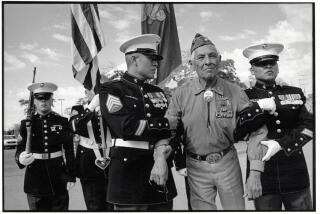Roosevelt’s signed Executive Order 9066 on Japanese American internment to go on view in L.A.
You are young, say, 10 years old, and you live in downtown Los Angeles near the intersection of East 1st and South San Pedro streets. You were born in this neighborhood, a three-mile radius that houses the largest Japanese American community in the U.S. You play stickball in the streets and walk your dog along the cracked, uneven sidewalks. It is home.
Today, however, Saturday, May 9, 1942, there is no stickball. You are given instructions, simple but devastating: Pack only what you can carry and abandon everything else, even the dog. Your family is to be shipped to an internment camp, where you will live in barracks, behind barbed wire, for the duration of World War II. You will never see the dog again.
A new exhibition at the Japanese American National Museum, “Instructions to All Persons: Reflections on Executive Order 9066,” revisits the internment experience through a specific lens. The museum has acquired, on loan from the National Archives, President Franklin Roosevelt’s original Executive Order 9066 calling for the incarceration of about 120,000 people of Japanese descent, most American citizens. On Saturday, the museum will open an exhibition commemorating the 75th anniversary of Roosevelt’s signing of that document, a somber day known as the Day of Remembrance.
The exhibit is particularly relevant today, curator Clement Hanami says, as new executive orders roll out regularly and after Trump signed an executive order, since halted, temporarily prohibiting citizens of seven predominantly Muslim countries from entering the U.S.
It’s “haunting” to see this kind of executive order being issued, Hanami says. “The story of the incarceration of Japanese Americans resonates today in the parallels between what happened to Japanese Americans then and what is happening to Muslim Americans now, after 2001. We felt compelled to stand up for these individuals, knowing that what happened to us could happen again.”
The hand-typed executive order, featuring Roosevelt’s black ink signature, will be on display for the first time on the West Coast. The document has been shown publicly just three times prior, all in Washington, D.C., exhibits. It will appear alongside the National Archives’ original Presidential Proclamation 2537, which is considered a precursor to the 9066 order, as it called for the registration of immigrants from enemy countries. The original documents will be on view until May 21, at which point they will be replaced by replicas.
The Japanese American National Museum exhibition was primary funded by the Broad Foundation.
“My wife, Edye, and I are old enough that we know what can happen when the political climate treads dangerously close to policies that seek to lock people up because of their religion or ethnicity,” Eli Broad says via email. “We’ve been here before. We must remember the past, or we are condemned to repeat it. We have a generation of students and young people — and even those who are not as young — who are not familiar with what happened 75 years ago. That’s why this exhibition is so important.”
The 75th anniversary of Roosevelt’s signing of Executive Order 9066 is significant, Broad adds, “for the simple reason that history holds [importance] for the present, especially now that executive orders are very much in the news. We cannot forget the tragedies they can inflict. America was founded on religious and ethnic freedoms, on the belief that all people, regardless of the color of their skin or their ancestry or their political views or their religion, have value and deserve to be treated with dignity and respect.”
In addition to marking the Day of Remembrance, the exhibition is intended to broach broader themes of civil rights, democracy and justice. Rounding out the exhibition, the museum will present other World War II-era government documents, some originals and other re-creations. That includes about 100 Civilian Exclusion Orders, which were posted publicly to notify Japanese Americans that they soon would be evacuated, along with so-called “loyalty questionnaires” issued to camp internees.
The museum also will display documentary video clips from the 1981 hearings of the Commission on Wartime Relocation and Internment of Civilians, a government study of the Japanese American internment. A wall timeline charts history from the bombing of Pearl Harbor to 9/11.
Hanami says it’s “really important for people to have spaces where they could decompress and contemplate the enormity of the experience.” So the museum will display artworks by L.A.-based Mike Saijo and Wendy Maruyama of San Diego as visual pressure-release valves.
Saijo created mixed-media drawings of Japanese Americans over pages from notable books, such as Jean-Paul Sartre’s play “No Exit” and the New Testament. Maruyama worked with volunteers to re-create about 30,000 camp identification tags, which she turned into a sculptural installation. Bundles of the tags hang from the ceiling, like the shaggy arms of a weeping willow tree.
“Seeing the sheer numbers of tags would be visually compelling,” Maruyama says. “Each grouping of tags would slowly turn, just rustle and murmur as people would pass by them, like the many voices of the individuals who were torn away from their livelihoods and homes.”
A series of performances will be staged in the exhibition galleries, a partnership with the theater company East West Players. Two actors will play three characters — a Japanese American, a Native American and a Muslim American — in short vignettes about cultural injustices.
A goal of the theater pieces is to create connections among audience members, no matter their ethnicity, and to spark dialogue about human rights.
“I think the exhibition will be quite powerful for people who are concerned about America today,” Hanami says. “Our goal is to create solidarity among all people, not just Muslim Americans. What ‘Instructions to All People’ illustrates is, even if we feel like something won’t directly affect us, we all need to stand up for each other.”
♦ ♦ ♦ ♦ ♦ ♦ ♦ ♦ ♦ ♦
‘Instructions to All Persons: Reflections on Executive Order 9066’
Where: Japanese American National Museum, 100 N. Central Ave., L.A.
When: Saturday to Aug. 13 (the original Executive Order 9066 on view until May 21)
Information: (213) 625-0414, www.janm.org
Follow me on Twitter: @debvankin
ALSO
George Takei is giving 70 years of his belongings to a museum. Here’s a sneak peek
Hollywood Bowl’s 2017 lineup: ‘Harry Potter,’ Misty Copeland, ‘Mamma Mia!’ and more
Al Pacino and the role that pulled him to the Pasadena Playhouse stage
How the Trump travel ban is already impacting L.A. arts institutions and artists
More to Read
The biggest entertainment stories
Get our big stories about Hollywood, film, television, music, arts, culture and more right in your inbox as soon as they publish.
You may occasionally receive promotional content from the Los Angeles Times.











